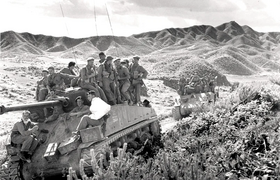The Northern Corridor Wars
| The Northern Corridor Wars | |||||||
|---|---|---|---|---|---|---|---|
| Part of the Third Joyonghean-Quenminese War and the Post Second Europan War Crisis of 1945 | |||||||
 An armoured column from the Nova Accordo Guards Regiment traversing a major road along the Northern Lorican Corridor, 1945 | |||||||
| |||||||
| Belligerents | |||||||
|
Lorican Front: Aurucolian Front: |
After September 1945:
| ||||||
| Commanders and leaders | |||||||
| Strength | |||||||
|
Initial: 950,000 By May 1945: 1,924,500 |
Initial: 1,750,000 By May 1945: 750,000 | ||||||
| Casualties and losses | |||||||
|
165,978 casualties
490 aircraft |
397,978 casualties
782 aircraft | ||||||
The Northern Corridor Wars (20 July 1945 - 17 July 1948) was a proxy war that marked the transition between the end of the Second Europan War and the Post Second Europan War Crisis of 1945. This was to be the continuation of the Third Joyonghean-Quenminese War that involved the objective of capturing remnants of the Imperial Quenminese Army that controlled Joyonghea from 1939 to 1944 and the hunt for Marshal Hồ Danh Sĩ Quốc and his staff, who had been deemed as responsible for many atrocities committed in Joyonghea during the war. The war was fought along the 6,000 km stretch of land and highways from the former Churuongchandat to the Lorican-Imperial border, with most of the engagement taking place along the Bahatsvan Corridor, which was a patch of land between the Autocratic East Europan Imperial Alliance, Aurucolia, and Lorica and the Northern Lorican Corridor, hence the name of the conflict.
Following the Imperial surrender on 25 August 1945, the remaining Imperial remnants led by Marshal Quoc refused to accept the surrender treaty that had been announced by the newly enthroned Quenminese Emperor Ngay Mung. The new Quenminese government had committed full total cooperation with the Allies, something which Marshal Ho refused to accept. And with the news of the death of his colleague in the south, Marshal Count Thạch Hung Sõn Chiến, he banded and formed the Anti-Treaty Forces that that included the Bằc Lạnh Provisional Government, Provisional Imperial Army, and the Archadian Provisional State of Lorica.
In October 1946, the Second Lorican Federal Republic collapsed and the Communist People's Republic of Lorica was proclaimed. The Anti-Treaty forces gained support from the new Communist government who offered asylum in exchange for Imperial technology should the Anti-Treaty forces win. This was unacceptable to the Allies and consequently, General Harry Kurosawa moved to prevent such agreement from taking place. Meanwhile, Sea Lord Kiriya Mountbatten requested the Allied forces that participated in the Southaern Indiae & Pakistania Campaign to aid Kurosawa. Allied forces from Aurucolia subsequently called to aid and attack the Imperial remnants from the Aurucolian border by way of the Bahatsvan corridor. The engagements that took place at the Bahatsvan corridor would be one of the most bloodiest and Imperial remnants would suffer heavy casualties until in 18 January 1948, when Dalmascan forces led by Marshal Nikolai Vilhelmsen finally closed the only route remaining for the Imperial forces to escape. The Ruzhite Empire government, although declaring a ceasefire in 1945 after the Imperial surrender, was forced to pull out its commitments and support to the Imperial remnants. However, Marshal Olav Timasheff refused to return and would declare to fight alongside Marshal Quoc until the end. He gathered the remnants of his army and formed a corps sized force known as Timasheff's Army, which had been banded by the Ruzhite government as a renegade force.
In 20 May 1948, the Communist Lorican government made a decision that put the final nail in the coffin with regards to the support that the Imperial remnants received, Lorican forces began pulling out of all battlefronts in the war, significantly reducing Imperial strength. By 18 June 1948, all Lorican forces had retreated from the northern corridor.
By summer of 1948, Kurosawa launched the final offensive of the war, the Karakorum Offensive of 1948, which drove Imperial forces from Muran to Ölgia. It is also in this offensive where forces from the Aurucolian and Lorican fronts finally met. Marshal Quoc was forced back to Ölgia the Imperial forces were subsequently surrounded by 10 July 1948. With casualties running high and ammunition low, Marshal Quoc and the rest of the Imperial commanders were forced to surrender, marking an end to the war. Marshal Hồ Danh Sĩ Quốc was subsequently put on trial for his crimes during the Third Joyonghean-Quenminese War and was sentenced to death.
Although the 3 year war put an end to Imperial ambitions to restart a conflict with the Allies, the Communist Lorican government began a tirade of issues and proxy conflicts across its neighboring borders. The consequent result led to the start of the 25-year War of Lorican Aggression.